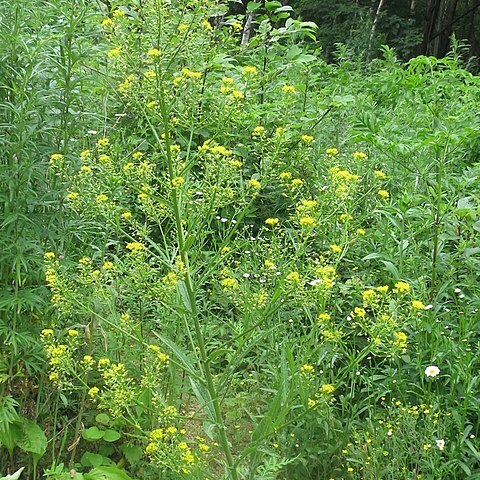Herbs annual or short-lived perennial, (20-)30-90(-120) cm tall, densely villous or hirsute at least near base, rarely glabrous above. Stems erect, simple at base, branched above. Basal leaves rosulate, soon withered; petiole 1-4 cm; leaf blade lyrate-pinnatifid or subruncinate. Lower and middle cauline leaves sessile, lanceolate, oblanceolate, or oblong, 2.5-10(-15) × 0.3-2.5(-4) cm, hirsute, lyrate-pinnatifid and with 1-3 lateral lobes on each side of midvein, sometimes leaves not lobed, base auriculate or amplexicaul, margin irregularly dentate, incised, or serrate, apex acute; terminal lobe not distinct or well developed and to 8 × 4 cm; uppermost leaves undivided, serrate, dentate, or serrulate. Racemes ebracteate. Fruiting pedicels divaricate, (2-)4-8(-10) mm, straight or slightly recurved, slender, glabrous or hirsute. Sepals oblong, spreading, (1-)1.3-1.8(-2) × 0.5-0.9 mm. Petals yellow, obovate, 0.7-1.3(-1.5) × 0.3-0.8 mm, apex obtuse. Filaments spreading, 1.2-1.8(-2) mm; anthers oblong, 0.4-0.5 mm. Ovules 60-100 per ovary. Fruit globose or subglobose, 2-3(-3.5) × (1.5-)2-3 mm; valves 2, papery, glabrous, not veined; gynophore 0.1-0.4 mm, sometimes absent; style stout, 0.1-0.8(-1) mm. Seeds dark reddish brown, broadly ovate, 0.5-0.8 × 0.4-0.5 mm, reticulate. Fl. and fr. Apr-Nov.
More
An annual herb. It is much branched. It grows 50-100 cm high. The base of the stem is woody. The leaves are broadly sword shaped and 5-10 cm long by 1-3 cm wide. They taper to the tip and the base is wedge shaped. The leaves on the stem clasp the stem at there base and are ear shaped at the base. They have coarse teeth. The flowers are yellow. They occur as many together in the axils of leaves and at the top of the plant. The pods are round and 2 mm across. There are many small seeds. They are oval and pale brown.

